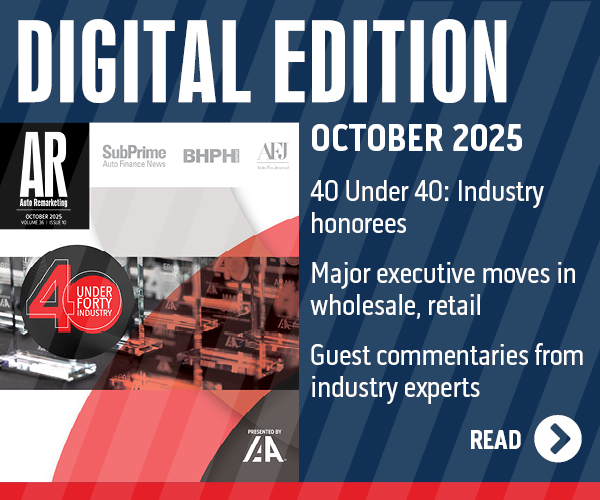Part of the dialogue happening at the recent SubPrime Forum during Used Car Week stemmed from whether or not finance companies — especially ones that specialize in subprime paper — were tightening their underwriting.
Furthermore, companies such as Consumer Portfolio Services had just discussed why their originations dipped during the third quarter.
Well, Experian’s latest State of the Automotive Finance Market report showed that perhaps underwriting in the subprime space is, in fact, tightening.
Experian’s Q3 data released on Monday indicated that financing extended to consumers in the subprime tier fell 4.5 percent from the previous year, and contracts to deep-subprime consumers dropped 2.8 percent to the lowest level on record since 2011.
Looking specifically at used-vehicle loans, analysts noticed that the subprime sectors saw an even larger decrease.
Financing to consumers with deep-subprime credit dropped by 5.3 percent to 5.11 percent; the lowest Experian has seen on record since tracking began in 2007.
Meanwhile, Experian senior director of automotive finance Melinda Zabritski — who discussed some of the Q3 data during the SubPrime Forum — pointed out that newly originated financing to prime borrowers jumped 2 percent to encompass nearly 60 percent of contracts financed in Q3.
“For anyone making doomsday predictions about a subprime bubble in the auto industry, Q3 2016 provides a stark reality check,” Zabritski said in a news release issued on Monday.
“This quarter’s report shows that lenders are reducing the percentage of loans to the subprime and deep-subprime risk tiers while increasing the percentage to consumers with good credit,” she continued. “The most important takeaway here is to understand the market reality and not to be led astray by rumors or unsubstantiated facts.
“By doing so, lenders, dealers and consumers are able to make smarter decisions and more easily explore financing programs and other opportunities available to them,” Zabritski went on to say.
The report also determined that average credit scores for both new and used vehicle loans are on the rise.
For new-vehicle contracts, the average credit score climbed two points to 712 in Q3, marking the first time average credit scores for new-vehicle loans rose since hitting a record high of 723 in Q2 2012.
For used-vehicle contracts, the average credit score jumped five points to 655.
Experian reported that 30-day delinquencies were flat year-over-year, at 2.36 percent. However, 60-day loan delinquencies were up slightly, moving from 0.67 percent in Q3 2015 to 0.74 percent in Q3 2016.
Beyond the subprime data, Experian highlighted that credit unions continued to gain market share as consumers search for low interest rates
Perhaps the biggest shift from Q3 2015 to Q3 2016 was the growth in market share for credit unions. Credit unions grew their share of the total loan market from 17.6 percent in Q3 2015 to 19.6 percent in Q3 2016.
For new-vehicle contracts, credit unions grew their share by 22 percent, going from 9.9 percent in Q3 2015 to 12 percent in Q3 2016.
According to the report, interest rate increases played a key role in helping boost credit union share. Interest rates for the average new-vehicle loan went from 4.63 percent in Q3 2015 to 4.69 percent in Q3 2016.
“Credit unions typically have the most competitive interest rates, so any time rates jump overall, it’s a natural reaction for credit unions to see a rise in their market share,” Zabritski said. “With vehicle prices and loan dollar amounts rising, car shoppers are looking for any relief they can get. Credit unions’ traditionally lower rates are obviously an attractive option.”
Other key findings for Q3 2016 included:
• Total open automotive financing balances reached a record high of $1.055 billion.
• Used-vehicle contract amounts reached a record high of $19,227, up by $361.
• The average new-vehicle contract amount jumped to $30,022 from $28,936.
• Share of new-vehicle leasing jumped to 29.49 percent from 26.93 percent.
• The average monthly payment for a new-vehicle contract was $495, up from $482.
• The average new-vehicle lease payment was $405, up from $398.
• The average monthly payment for a used-vehicle contract was $362, up from $360.
• The average contract term for a new vehicle was 68 months.
Lending Club, which claims to be the world's largest online marketplace connecting borrowers and investors, this week announced the launch of an auto refinance product that is designed to give vehicle owners a simple solution to save money on their installment contracts.
The product is being launched initially to California residents, with plans to expand nationally in early 2017.
In less than a minute, consumers can check their rate online to see what they might qualify for based on their credit profile and ability to repay, as well as the make, model, mileage and current value of their vehicle.
Once a borrower selects an offer, completes the application process and is approved, WebBank will issue a new loan ranging from $5,000 to $50,000, with terms ranging from two to six years and APRs starting at 2.49 percent and up to 19.99 percent, and Lending Club will facilitate paying off a borrower's existing contract.
Lending Club president and chief executive officer Scott Sanborn explained this auto refinance product leverages the company’s technology and expertise to help eligible consumers save money by refinancing into more affordable terms with better rates, clear terms and no hidden fees.
“Tens of millions of Americans borrow over half a trillion dollars every year to buy cars,” Sanborn said. “The practices and processes of the auto lending industry offer consumers limited options and a lack of transparency. This has created a gap between the rates consumers pay and the rates they might otherwise qualify for, unnecessarily driving up debt burdens.
“We are excited to leverage our technology and core capabilities to put thousands of dollars back in consumers' pockets,” he continued.
Lending Club has become one of the nation’s largest platform for personal loans, primarily by helping consumers gain access to lower interest rates as compared to traditional options such as high-interest credit cards. The company declared that currently there is more than $1 trillion in outstanding auto debt, with just a fraction of that figure — $40 billion — refinanced annually.
The company thinks this ratio represents huge potential for both Lending Club's platform and the millions of Americans who could save by refinancing into a more affordable product.
Lending Club estimated the average APR for borrowers on new contracts through Lending Club will be about 1 percent to 3 percent lower than their current contract, translating into an average savings of up to $1,350 over the life of the loan.
“This is Lending Club's first offering of access to a secured loan with an overall risk and return profile that's complementary to the unsecured loans available through our platform. It’s a big step in the evolution of our platform, a win for consumers, and will give our investors access to another proven asset,” Sanborn said.
Customers can find out more about their auto refinancing options through Lending Club at lendingclub.com/apply/site/auto-refinancing.
The potential for more vehicle installment contract holders in your portfolio to use their smartphone to make regular payments to keep their auto financing current took another step forward on Monday.
Early Warning announced preliminary details of a tool named Zelle, what it’s calling a new, faster payments network that will “revolutionize” how U.S. consumers and businesses send and receive money. The company indicated Zelle will launch in early 2017 and will be directly embedded within mobile banking channels of its network banks, which already includes some large auto finance players such as Ally, Capital One and Wells Fargo.
A consumer-facing app for person-to-person (P2P) payments will be released in 2017, according to Early Warning.
Early Warning insisted Zelle will change how money moves, empowering millions of consumers with a faster, safer way to send and receive payments within the security of their financial institution. Zelle will provide an intuitive and user-friendly experience for network bank customers who want to send, request and split payments with their friends and family.
Payments can be sent using just an email address or mobile phone number from within the mobile banking experience of network banks or using the Zelle app. Anyone with a valid checking or savings account can receive payments by quickly registering at ZellePay.com, or by using the Zelle app with a valid debit card account.
“Zelle will transform how people manage their financial lives, providing them faster, safer and more convenient payment options with their friends and family,” Early Warning chief executive officer Paul Finch said. “We are pleased to partner with the leading financial institutions and financial service organizations in the country to make our vision for faster payments a reality for millions of consumers nationwide.”
Zelle is an inclusive network that is open to all banks and credit unions in the U.S. At launch, officials pointed out Zelle will be one of the largest payment networks in the U.S., accessible to more than 76 million mobile banking users nationwide. A total of 19 financial institutions have joined the Zelle Network, including eight of the largest retail banks in the U.S.
“Zelle is an always-on, easy to use mobile payment capability that gives our customers one more secure, convenient way to stay connected and live their financial lives,” Bank of America chief executive officer Brian Moynihan said.
The following financial institutions will join the Zelle Network: Ally Bank, Bank of America, Bank of the West, BB&T, BECU, Capital One, Citi, Fifth Third Bank, FirstBank, First Tech Federal Credit Union, Frost Bank, JP Morgan Chase, Morgan Stanley, PNC, USAA, U.S. Bank and Wells Fargo.
“The Zelle Network is an innovative, faster, and more secure way for PNC customers to send person-to-person payments,” said William Demchak, chairman, president and chief executive officer of The PNC Financial Services Group. “I believe our customers will appreciate the convenience and security of Zelle when the network goes live early next year.”
Early Warning has partnered with payment processors CO-OP Financial Services, FIS, Fiserv, and Jack Henry, as well as global card networks Mastercard and Visa to offer banks and credit unions multiple integration pathways onto the network as well as to increase the speed-to-market for new network members.
“Paying a friend with Zelle on a mobile device is the way of the future,” said Richard Davis, chairman and chief executive officer of U.S. Bancorp. “Zelle is better for both the sender and recipient. There’s no waiting for a check to arrive, or stopping for cash on your way home to pay the babysitter. We’re delighted to be a part of the Zelle Network as one of the first banks to offer Zelle to our U.S. Bank customers.”
While the Federal Reserve chose again to pass on moving interest rates higher, research from TransUnion found that up to 92 million credit-active consumers would experience some type of monthly debt service payment increase if policymakers had raised interest rates by 25 basis points.
However, TransUnion determined the average monthly payment increase for these consumers would be a mere $6.45. Further reassuring for finance companies, analysts insisted only about 10 percent of these impacted consumers — or 9.3 million — will likely not have the capacity to absorb an increased monthly payment obligation arising from a Fed rate hike.
To recap, this month’s gathering of the Federal Open Market Committee (FOMC) produced a result the industry has seen for much of the past couple of years — members leaving the federal funds rate unchanged.
“The committee judges that the case for an increase in the federal funds rate has strengthened but decided, for the time being, to wait for further evidence of continued progress toward its objectives,” the Fed said last week.
“The stance of monetary policy remains accommodative, thereby supporting further improvement in labor market conditions and a return to 2 percent inflation,” policymakers added.
The Fed explained that information received since the FOMC met in July showed that the labor market has continued to strengthen and growth of economic activity has picked up from the “modest” pace seen in the first half of this year.
“Although the unemployment rate is little changed in recent months, job gains have been solid, on average,” the Fed said.
Policymakers also pointed out household spending has been growing strongly but business fixed investment has remained soft. Inflation has continued to run below the committee’s 2 percent longer-run objective, partly reflecting earlier declines in energy prices and in prices of non-energy imports.
The Fed went on to say market-based measures of inflation compensation remain low; most survey-based measures of longer-term inflation expectations are little changed, on balance, in recent months.
Before the Fed made its decision, TransUnion found that up to 68 percent of credit-active consumers would experience some level of payment shock — a change in monthly payment obligations — from an interest rate increase. Analysts insisted that unlike vehicle installment contracts that have a fixed APR for the term, consumers who are susceptible to a payment shock have one or more variable-rate credit products in their wallets, such as a credit card, home equity line of credit, or certain forms of mortgages and personal loans.
TransUnion also analyzed historical payment behavior across each consumer’s credit wallet to assess whether that consumer could afford an increased monthly payment of any size.
“Ahead of a potential rate hike from the Federal Reserve, there is much speculation about the impact to consumers — and their lenders — from increased monthly payments,” said Nidhi Verma, senior director of research and consulting in TransUnion’s financial services business unit.
“In theory, 137 million consumers could be exposed to a payment shock, but in fact not all of these consumers will be impacted,” Verma continued. “For instance, some consumers are transactors, i.e., they pay their balances in full each month. Some have an APR that cannot be further increased.
“Our data show there will indeed be an impact from potential interest rate rises, but it’s far less widespread than many anticipate,” she went on to say. “Most importantly, it can be identified at a consumer level based on our research.”
According to TransUnion’s study, while consumers across all risk tiers would experience an impact from the potential Fed interest rate hike, the impact varies. Consumers in the near-prime risk tier (those with a VantageScore 3.0 credit score between 601 and 660) had the largest share, with 82 percent of near-prime consumers impacted from a potential rate increase.
TransUnion used its CreditVision aggregate excess payment (AEP) algorithm, which incorporates monthly payments from mortgages, credit cards and other debt obligations, to determine a consumer’s capacity to afford an increased monthly payment. With a 25-basis point rise in interest rates, 90 percent of exposed consumers can absorb their respective payment shocks. However, 9.3 million consumers do not appear to have the capacity to absorb a 25 basis point rise in interest rates.
“While it’s important to address the 9.3 million consumers who cannot absorb the payment shock, 90 perent percent of exposed consumers can afford their increased monthly payments,” Verma said. “However, if interest rates continue to rise progressively, more consumers might not be able to absorb the payment shock.
Lenders should be mindful of which consumers in their portfolio are at risk from payment shocks, and use solutions such as AEP to identify these consumers and engage them appropriately,” she added.
TransUnion’s study found that if interest rates were to rise by 100 basis points, an additional 2.5 million consumers might have a negative capacity to absorb their respective payment shocks. In total, 11.8 million consumers are estimated to be at risk of a negative capacity to absorb their increased payment obligations from a sudden 100 basis point rate increase.
“Fortunately, we believe it is highly unlikely the Fed will raise rates more than 25 basis points at any one time over the near term,” Verma said. “This pace gives potentially impacted consumers an opportunity to adjust. In many cases, making minor changes to household spending would allow consumers to accommodate the payment shock.”
Verma discussed TransUnion’s finding more in the video available at the top of this page and also posted here.
For more information on how the impact of a Fed interest rate hike might impact consumers, and how to use TransUnion’s CreditVision aggregate excess payment algorithm to estimate the risk in your portfolio, visit www.transunioninsights.com/interestrates.
FactorTrust is looking for finance companies to add another consumer definition to their lexicon, encouraging lenders to examine the underbanked population with a new lens.
FactorTrust is advocating that the 113 million U.S. consumers with FICO credit scores currently below 700 should be recognized as CreditClimbers — consumers determined to improve their credit scores in order to advance their situation and access more credit options.
“Lenders must adjust their perception about the underbanked and no-score consumers,” FactorTrust chief executive officer Greg Rable said. “There are 26 million U.S. adults who have no credit history with the Big 3 bureaus. This is a massively underserved population that, when taking alternative credit data into account, deserve credit options."
FactorTrust’s data demonstrates these Americans indeed are striving for a better financial standing,” Rable continued. “Using alternative credit data, lenders can grow their business by strategically evaluating and marketing to CreditClimbers.”
While the percentage of unbanked consumers has decreased over the past five years, the number of underbanked consumers has remained relatively stable, according to the FDIC. Rable insisted the historical perception that the underbanked are all risky customers has harmed both consumers and finance companies, impeding industry and economic growth.
“Every time a CreditClimber does something positive, they deserve to improve their credit score,” he said. “The problem is that the vast majority of these customers and their credit performance are simply unrecognized and untracked by the Big 3 bureaus.
“We’ve seen people improve their credit scores — at every scoring level — by having alternative credit data factored in during the underwriting process. More data is better for both the consumer and the lender,” Rable went on to say.
With used-vehicle financing leading the charge, Experian’s latest State of the Automotive Finance Market report showed finance companies booked significantly more contracts with super-prime customers during the second quarter than they did with deep subprime consumers.
Creating what analysts called steady growth and remarkable stability quarter-over-quarter, the second-quarter report released on Tuesday indicated that auto finance companies made more than five times as many loans to super-prime customers (17.9 percent of total auto loans and leases) as to deep-subprime customers (3.5 percent of total auto loans and leases).
That influx of higher-grade paper meant the combined subprime and deep-subprime share of new- and used-vehicle loans and leases dropped from 23.3 percent in Q2 2015 to 22.8 percent in Q2 2016, according to Melinda Zabritski, senior director of automotive finance for Experian.
“Automotive lenders seem to be keeping cool heads when it comes to how much risk they are willing to take with subprime and deep-subprime customers,” said Zabritski, who is coming back to the SubPrime Forum at Used Car Week for the fourth consecutive year to share more data and trends.
“Yes, subprime and deep-subprime loans are growing, but the entire market is growing from a volume perspective across all risk tiers,” she continued. “In fact, the subprime loans have actually dropped as a percentage of the total market. That, combined with only a slight uptick in delinquencies, makes clear that the sky is not falling.”
Experian determined 30-day delinquencies inched up just 3 basis points year-over-year from 2.19 percent in Q2 2015 to 2.22 percent in Q2 2016. Meanwhile, Experian found that 60-day delinquencies moved just 6 basis points higher from 0.56 percent to 0.62 percent in the same time period.
“Fear of an impending automotive subprime bubble has been swirling around the industry since the recovery from the Great Recession,” Experian said. “Those fears haven’t come to fruition.”
Overall, Experian reported that finance companies held $1.027 trillion in outstanding balances through the second quarter; that’s up from $932 billion a year earlier.
Each of the four major categories of providers that Experian designates posted year-over-year gains in outstanding balances. Those four categories include commercial banks (up by $27 billion), captives (up $13 billion), credit unions ($33 billion) and finance companies that do not hold deposits and often take on subprime risk (up $21 billion).
More used paper in portfolios
Experian highlighted used-vehicle loans grew to record heights in terms of average dollar amount and overall loan share during the second quarter.
The average used vehicle loan reached an all-time high of $19,101 in Q2, up from $18,671 in Q2 of last year.
Used-vehicle contract volume also reached a new peak, accounting for 55.61 percent of all vehicle loans during the second quarter.
Analysts noticed the growth was driven by jumps in prime and super-prime consumers choosing used vehicles. Specifically, 43.3 percent of super-prime consumers selected a used vehicle, which represents a 10 percent increase over 2015. For prime consumers, 59.9 percent chose used, a 6.6 percent increase over the previous year.
This shift also helped push the average credit score for a used vehicle loan from 645 in Q2 2015 to 648 in Q2 2016.
“One of the biggest trends we continue to see is the shift to used vehicles by customers with excellent credit,” said Zabritski, who will appear during the SubPrime Forum, which runs Nov. 14-16 at the Red Rock Resort and Casino in Las Vegas.
“As vehicle prices continue to rise, savvy consumers are looking for ways to control costs. That appears to be pushing more customers toward used vehicles,” she went on to say.
Other Q2 2016 findings:
• The average monthly payment for a used vehicle was $364, up from $361 in Q2 2015.
• The average monthly payment for a new vehicle loan was $499, up from $483 in Q2 2015.
• The average new vehicle loan amount was $29,880, up $1,356 from the Q2 2015 average new vehicle loan amount of $28,524.
• Average customer credit scores for new vehicle loans fell slightly, from 709 in Q2 2015 to 708.
• The average loan term for a new vehicle went from 67 months in Q2 2015 to 68 months.
Dealer Marketing Services, the makers of ProMax Unlimited, recently released the third solution in a line of three consumer credit soft pull products. The latest addition is the Instant Auto Credit App, an Equifax-powered version of the popular online soft pull solution.
Since the entire trio is now available, ProMax Unlimited indicated the three products can be deployed by dealers individually or as an entire product suite.
The Instant Auto Credit App can allow visitors to a dealership’s website to pre-qualify for auto financing. Consumers who wish to be pre-qualified are required to fill out a short application and verify their identity, in exchange for an offer that includes a maximum loan amount and a range of possible interest rates.
The dealership in turn can receive a pre-qualified lead.
“Leads are the lifeblood of the auto business,” ProMax chief operating officer Shane Born said. “This powerful soft pull tool goes a long way toward converting anonymous website visitors into auto sales and can be used for customers already at the dealership, showroom walk-ins and service lane customers.”
Instant Score, which was the first of the three Equifax-powered credit solutions to be released, can function as a simple plug-in to any page on a dealership’s website. Using Instant Score, visitors to a dealership’s website are able to see their Equifax credit score free of charge. This simple process only requires consumers to fill out a short form and verify their identity, but does not require some personally identifiable information, such as a social security number.
Upon completing the form and having their identity verified, the consumer may view their credit score, and the dealership receives a high quality authenticated lead.
“Our dealership customers highly value prospects that are sourced from their own websites and service lanes,” ProMax chief executive officer John Palmer said. “The PowerLead service from Equifax enables us to help validate consumer identities and performs a soft pull of a customer’s credit file to assess customers quickly and easily. This is why we are so excited to offer our dealerships the valuable services of each of these three products.”
Back in April, the company highlighted Instant Screen powered by Equifax; a solution that can enable dealers to provide a firm offer of credit at the dealership level. Customers shopping for a vehicle or in for a service appointment can be prescreened according to finance company’s predetermined credit criteria.
“The release of these three solutions solidifies our status as the industry leader in automotive dealer soft pull credit products,” ProMax chief technology officer Darian Miller said. “No one else boasts as wide a variety of automotive pre-screen tools.”
For more details, go to www.ProMaxUnlimited.com.
TransUnion senior vice president and automotive business leader Jason Laky indicated auto refinancing still is a “small” portion of all new quarterly originations. However, start-up companies such as SpringboardAuto.com are aiming to boost the volume figure by creating online opportunities for consumers to apply for refinancing anywhere, anytime and receive a response in seconds.
During a conversation earlier this week with SubPrime Auto Finance News, Laky estimated that auto refinancing composes about 5 percent to 10 percent of quarterly originations.
“But we’ve seen it grow year-over-year since 2010,” Laky said. “We believe that this is a combination of both a favorable interest rate environment as well as more lenders seeing auto refinancing as an opportunity to create value for consumers, especially when consumers have long-term loans.”
Long-term contracts certainly are the norm nowadays. Experian Automotive’s first-quarter data indicated the average term for a subprime borrower who financed a new vehicle came in at 72 months. If a subprime buyer made a financed purchase of a used vehicle at a franchised dealer during Q1, the term was 67 months. If the subprime used-vehicle transaction took place at an independent store, the average term was 56 months.
Perhaps if those subprime borrowers improved their credit standing after a time, they might seek refinancing options to reduce their monthly payment. Laky explained how TransUnion can keep track of originations that are, in fact, refinancing deals.
“One of the criteria is a different lender,” Laky said. “This isn’t modifying a loan for an existing consumer as much as it is this conquest piece.
“When we see it, it tends to be certain finance companies that specialize in auto refinance as opposed to offering it side-by-side with an indirect program. It can be hard to do both,” he continued.
Companies such as SpringboardAuto.com are trying to reduce the difficulty of obtaining financing altogether.
Unlike the traditional refinancing process that only has static single terms (such as a fixed interest rate and payment), SpringboardAuto.com insisted that it can put the consumer in control of displayed loan term options. The application process is automated, transparent and can be done 24/7 from anywhere using a smartphone or computer.
SpringboardAuto.com chief executive officer Jim Landy explained that approved consumers configure selected financing terms to meet their individual objectives, which can be to lower an existing monthly payment or reduce the amount of interest paid. Landy also stressed there’s no obligation to commit and no impact on a consumer’s credit score to receive an offer.
“Refinancing an auto loan shouldn’t involve any smoke and mirrors. We educate buyers up front on interest rate, loan duration and even include a slider tool to help them see how more or less money down changes the terms of the loan,” he said.
“The bottom line: We will either be able to give a consumer a loan that better meets their needs or not,” Landy continued. “If not, there’s no harm to the consumer’s credit score and no obligation.”
During the refinance process, SpringboardAuto.com can provide a side-by-side presentation of the consumer’s estimated current loan compared to their new loan term preferences; and, because there is full transparency, the consumer knows if the loan is beneficial or not.
“The reasons to refinance are unique to every individual — it might be that you’re about to become a new parent and the costs associated with the new baby mean you really need a lower monthly payment, or perhaps you’re ready to shorten the loan duration and pay the vehicle off faster. Whatever the need, our tool lets you easily configure the loan to fit,” Landy said.
SpringboardAuto.com’s refinancing auto loans are available via website or smartphone. The company leverages technology, data and analytics to expedite and secure the entire financing process.
Once approved and the contract configured, SpringboardAuto.com can guide the borrower through the rest of the refinance process and the loan agreement is signed online for everyone’s convenience.
Jason Laky, senior vice president and automotive business leader for TransUnion, explained that there are generally two reasons why consumers would want to take on a longer-term vehicle installment contract. One reason can be a positive for a finance company; the other motive perhaps not so much.
“One is that they plan to hold onto the car for a longer period of time so the term of the loan matches the useful life of the vehicle. And that’s a good thing,” Laky said.
“There’s another set of consumers that extended terms are the only way in which to get a payment they can afford. And that’s a little riskier for a lender,” he continued.
“We’re suggesting that lenders as a part of their check-up consider tools that help better understand how a consumer can afford a monthly payment,” Laky went on to say during a conversation with SubPrime Auto Finance News ahead of the newest study TransUnion released on Tuesday.
TransUnion’s latest research project found that even as the term of new auto loans has increased, the duration of time a consumer remained in these loans has declined.
The study indicated that the average term for new auto loans rose from 62 months in 2010 to 67 months in 2015. In the third quarter of 2015, seven in 10 new auto loans had terms longer than 60 months. Five years prior, only half of all loans had terms longer than 60 months.
The study found that, despite the proliferation of longer loan terms, auto loan duration — the length of time a consumer keeps a loan and such loan remains in a finance company’s portfolio — has declined. For contracts originated in 2012, the average spread between term and duration has grown by nearly one month compared to loans originated in 2010. The study explored contracts in this period to provide sufficient time for the loans to mature to payoff.
Laky insisted this trend is important for finance companies because as borrowers remain in their auto loans about one month less, finance companies may not be capturing the benefits of more payments and greater interest income they might expect from longer-term loans.
“I think the industry is not surprised when longer-term loans have higher delinquency,” Laky said. “I think the question is — and each lender has to answer this one — is this a lot more than you would have expected?
“From a lender’s perspective, it’s ensuring that for those changes in credit risk that you’re getting compensated from an APR perspective,” he added.
TransUnion’s study found that auto loan terms between 73 and 84 months have more than doubled between 2010 and 2015. One quarter of all loans originated in Q3 2015 were between 73 and 84 month terms, compared to just 10 percent in Q3 2010.
TransUnion also mentioned that even as average new auto loan amounts increased between 2010 and 2015, the average monthly payment declined as consumers selected extended terms.
In Q3 2015, the average new auto loan amount was $21,368, compared to $18,008 in Q3 2010. By the third quarter of 2015, the average new auto loan payment had declined to $398 per month from $420 per month in Q3 2010.
Even with smaller monthly payments, the study found that consumers with longer loans are more likely to be seriously delinquent (defined as ever 60 days or more past due) than borrowers with shorter terms, even when controlling for credit risk score.
Serious Delinquency Rates for Auto Loans by Term
| Loan Term |
Subprime |
Prime |
Super-prime |
| 49-60 months |
22.4% |
3.4% |
0.4% |
| 61-72 months |
22.8% |
5.0% |
0.9% |
| 73-84 months |
30.7% |
7.1% |
1.8% |
“Longer auto loan terms allow consumers to keep payment levels reasonable as they finance more expensive vehicles,” Laky said in a TransUnion news release. “However, consumers who cannot afford the monthly payment on a shorter term for the same loan are riskier, and we see this manifested in the higher delinquency rates for 72- and 84-month loans.
“We encourage lenders to use readily available risk analysis tools to identify borrowers who are more likely to go delinquent with an extended term, to ensure consumers are receiving loans that they can manage,” he continued.
TransUnion’s study also revealed that the risk from longer-term loans lessened when consumers had sufficient cash flow for a new auto loan.
TransUnion used its CreditVision aggregate excess payment (“AEP”) algorithm, which incorporates monthly payments from mortgages, credit cards, student loans and other debt obligations, to determine a consumer’s capacity to afford a new auto loan payment.
The study determined that across all risk tiers, consumers with a positive AEP — meaning they have money available after their monthly minimum payments are made — performed better. Consumers across all risk tiers who had negative AEP values were more likely to be delinquent on their auto loans.
Delinquency Rates and AEP of Loans Originated between 73 and 84 Months
| Aggregate Excess Payment |
Subprime |
Prime |
Super-prime |
| Positive |
23.3% |
5.0% |
1.4% |
| Negative |
30.0% |
8.5% |
2.6% |
“Aggregate excess payment is a powerful, predictive tool for determining whether a borrower is likely to repay a loan,” Laky said. “Lenders can use solutions such as CreditVision aggregate excess payment to understand the differences between consumers who choose a longer loan term and those who need a longer auto loan term.”
This study is the latest in recent projects TransUnion has rolled out since the initial launch of Prama Insights, which includes anonymized information on virtually every credit active consumer in the U.S. The data set leverages the power of CreditVision and a seven-year historical view of data, providing finance companies with what TransUnion calls “dynamic” insights that can translate into “clear” benefits at every touchpoint.
Earlier this summer, TransUnion leveraged its new tools to find that average daily auto originations are 84 percent higher in the 30 days after mortgage payoff compared to the 30 days prior to that event.
“We are emerging from our transformation from a corporate IT system and a mainframe to an open-systems environment,” Laky told SubPrime Auto Finance News. “That’s enabled us to create very broad and very deep analytic databases. Those are allowing us to do much more research in much closer to real time.
“Hopefully it will allow us to increase the pace at which we can do studies like this to support our auto finance community,” he went on to say.
To learn more about TransUnion’s auto study and solutions for finance companies, visit this website.
Subprime Analytics recently reported the largest reduction in subprime auto finance down payments since 2011. Subprime auto finance down payments experienced a 15 percent year-over-year decrease in 2015. While down payments are down, the amount financed is up. According to Experian Automotive, the average used-vehicle loan amount for franchised and independent dealers increased to $18,424 in Q1 of this year.
With the combination of these two trends, it’s no wonder that average subprime loan terms have increased by 4.5 percent year-over-year since 2012, according to Subprime Analytics. Now lenders are looking to extend loan terms to 84 months.
What do these trends mean for the long-term? For the last year, industry analysts have been telling everyone to wait and see. But, when does waiting and seeing turn into putting our heads in the sand?
Rather than waiting for the market to turn, and reacting to the circumstances that arise, smart lenders are taking proactive steps now to protect their lending portfolios from potential market changes.
Now, you might think, “I don’t want to be the first lender to start tightening lending requirements and lose loan volume and market share.” The good news is you don’t have to jump the gun. Rather, take a step back and look outside the box for solutions that can protect your portfolio and increase loan volume.
One such “out-of-the-box” approach is the use of consumer protection products, like a vehicle service contract or vehicle return protection. Loans that offer complimentary consumer protection products can help you address the challenges of differentiating yourself from the competition and managing delinquency rates, while also providing additional streams of revenue.
As far as dealers are concerned, whether you provide complimentary products or not, they will want a lender that funds enough money for them to either increase their profit through upgrades or selling their own F&I products. Offering loans to dealers that help them achieve their goals has the potential to make you their preferred lender, meaning increased auto loan volume.
From the consumer side of things, subprime buyers tend to struggle with budgetary constraints. For example, when a significant mechanical breakdown occurs, these consumers often have to choose between paying for the repair or paying a monthly bill like their auto loan. A complimentary vehicle service contract or other related program could alleviate that cost, and potentially protect the loan from delinquency, thereby protecting your loan portfolio.
By providing dealers and consumers what they need, you can essentially set yourself up for long-term success. It’s a win, win, win! Rather than waiting to see what the market brings, take control of your financial future with consumer protection products.
Steve Roennau is the vice president of compliance EFG Companies. This commentary originally appeared on the company’s website.












